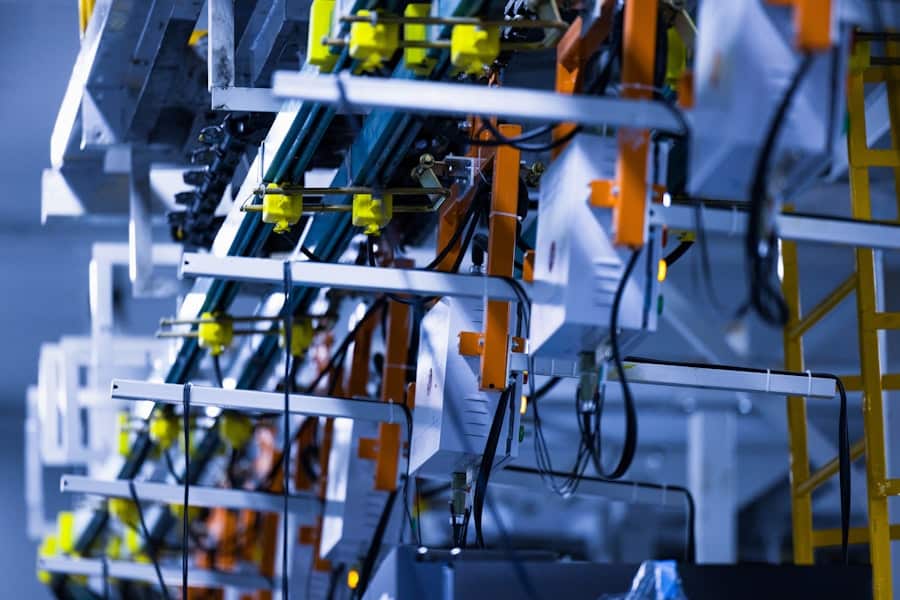The evolution of 3D printing has been marked by significant technological advancements, and automation stands out as a pivotal force driving this transformation. Initially, 3D printing was a labor-intensive process, requiring skilled operators to manage the intricate machinery and ensure precision in the production of parts. However, as the demand for rapid prototyping and customized manufacturing surged, the industry began to embrace automation to enhance efficiency and scalability.
The integration of automated systems has allowed manufacturers to streamline workflows, reduce human error, and increase production rates, making 3D printing a more viable option for mass production. The rise of automation in 3D printing is also closely linked to the development of sophisticated software and hardware solutions. Advanced robotics, coupled with machine learning algorithms, have enabled printers to operate with minimal human intervention.
For instance, automated systems can now monitor print quality in real-time, adjusting parameters on-the-fly to ensure optimal results. This shift not only enhances the reliability of 3D printed products but also opens up new possibilities for complex geometries and designs that were previously unattainable.
Key Takeaways
- Automation in 3D printing is on the rise, leading to increased efficiency and productivity in the industry.
- Advantages of automated 3D printing include reduced labor costs, faster production times, and improved consistency in output quality.
- Challenges and limitations of automation in 3D printing include high initial investment costs, limited flexibility in design changes, and potential job displacement.
- Automation technologies in 3D printing encompass robotic arms, automated material handling systems, and software for process control and monitoring.
- The impact of automation on the 3D printing industry includes increased competitiveness, expanded market opportunities, and the potential for reshoring manufacturing.
Advantages of Automated 3D Printing
One of the most significant advantages of automated 3D printing is the substantial increase in production speed. Traditional 3D printing methods often require extensive manual setup and monitoring, which can lead to bottlenecks in the manufacturing process. Automation eliminates much of this manual labor, allowing for continuous operation and faster turnaround times.
For example, automated systems can run overnight or during off-peak hours without the need for constant supervision, significantly increasing output while reducing labor costs. In addition to speed, automated 3D printing enhances precision and consistency in production. Automated systems are equipped with advanced sensors and feedback mechanisms that monitor various parameters throughout the printing process.
This capability ensures that each layer is deposited with exacting accuracy, minimizing defects and variations between parts. Industries that require high levels of precision, such as medical device manufacturing or aerospace components, benefit immensely from this consistency. Furthermore, automation allows for the replication of complex designs with high fidelity, enabling manufacturers to produce intricate parts that meet stringent regulatory standards.
Challenges and Limitations of Automation in 3D Printing

Despite its numerous advantages, the automation of 3D printing is not without its challenges and limitations. One significant hurdle is the initial investment required for automated systems. High-quality industrial 3D printers equipped with automation capabilities can be prohibitively expensive for small and medium-sized enterprises (SMEs).
This financial barrier can limit access to advanced technologies and hinder innovation within smaller companies that may not have the resources to invest in such systems.
Many organizations have established processes that may not easily accommodate new automated technologies.
Transitioning to an automated system often requires a complete overhaul of production lines, staff retraining, and adjustments to supply chain logistics. This transition can be time-consuming and may lead to temporary disruptions in production. Additionally, there is a risk that over-reliance on automation could lead to a loss of skilled labor in the industry, as fewer operators are needed to manage automated systems.
Automation Technologies in 3D Printing
The landscape of automation technologies in 3D printing is diverse and continually evolving. One prominent technology is robotic arms that can manipulate print heads or build platforms with high precision. These robotic systems can perform tasks such as layer deposition or post-processing operations like sanding and painting, significantly enhancing the capabilities of traditional 3D printers.
For instance, companies like MX3D have developed robotic arms capable of 3D printing metal structures in mid-air, showcasing the potential for creating complex geometries that were previously impossible. Another key technology is the use of software automation tools that facilitate design optimization and workflow management. Software platforms equipped with artificial intelligence can analyze design files and suggest modifications to improve printability or reduce material waste.
These tools can also automate scheduling and resource allocation within a production environment, ensuring that machines are utilized efficiently. For example, software solutions like Autodesk’s Fusion 360 integrate design and manufacturing processes, allowing users to automate various aspects of their workflow from conception to final product.
Impact of Automation on 3D Printing Industry
The impact of automation on the 3D printing industry is profound and multifaceted. As companies adopt automated solutions, they are able to scale their operations more effectively, leading to increased competitiveness in the global market. The ability to produce high-quality parts at a lower cost has made 3D printing an attractive option for industries looking to innovate and reduce time-to-market for new products.
This shift has led to a surge in demand for 3D printed components across various sectors, including automotive, aerospace, and consumer goods. Moreover, automation has facilitated the democratization of 3D printing technology. As automated systems become more accessible and affordable, smaller companies and startups are entering the market with innovative applications and business models.
This influx of new players fosters creativity and competition, driving further advancements in technology and applications. For instance, companies specializing in on-demand manufacturing services are leveraging automated 3D printing to offer customized products at scale, catering to niche markets that were previously underserved.
Future Trends in Automated 3D Printing

Looking ahead, several trends are poised to shape the future of automated 3D printing. One notable trend is the increasing integration of additive manufacturing with other advanced manufacturing technologies such as subtractive machining and injection molding. Hybrid systems that combine these processes can offer greater flexibility and efficiency in producing complex parts with varying material properties.
For example, a hybrid machine might use additive techniques to create intricate internal structures while employing traditional machining methods for external features. Another trend is the growing emphasis on sustainability within automated 3D printing processes. As environmental concerns become more pressing, manufacturers are exploring ways to minimize waste and energy consumption associated with production.
Innovations such as bio-based materials and recycling technologies are gaining traction, allowing companies to produce parts with a lower environmental footprint. Additionally, automated systems can optimize material usage by precisely calculating the amount needed for each print job, further reducing waste.
Integration of Automation and Artificial Intelligence in 3D Printing
The convergence of automation and artificial intelligence (AI) is revolutionizing the capabilities of 3D printing technology. AI algorithms can analyze vast amounts of data generated during the printing process to identify patterns and optimize performance. For instance, machine learning models can predict potential failures based on historical data, allowing operators to intervene before issues arise.
This predictive maintenance capability not only enhances reliability but also extends the lifespan of equipment by preventing costly breakdowns. Furthermore, AI-driven design tools are transforming how products are conceptualized and developed. Generative design software utilizes AI algorithms to explore a multitude of design alternatives based on specified parameters such as weight reduction or material efficiency.
This approach enables engineers to discover innovative solutions that may not have been considered through traditional design methods. By integrating AI into automated 3D printing workflows, manufacturers can achieve unprecedented levels of efficiency and creativity.
Ethical and Legal Considerations in Automated 3D Printing
As automation becomes increasingly prevalent in 3D printing, ethical and legal considerations must be addressed to ensure responsible use of technology. One major concern revolves around intellectual property rights. The ease with which digital files can be replicated raises questions about ownership and copyright infringement.
Manufacturers must navigate complex legal frameworks to protect their designs while also respecting the rights of others. Additionally, there are ethical implications related to job displacement as automation takes over tasks traditionally performed by humans. While automation can lead to increased efficiency and lower costs, it also poses challenges for workers who may find their skills rendered obsolete.
Companies must consider how they can retrain employees for new roles within an increasingly automated environment while fostering a culture that values human contributions alongside technological advancements. In conclusion, while automation presents numerous opportunities for enhancing the capabilities of 3D printing technology, it also brings forth challenges that require careful consideration from industry stakeholders. Balancing innovation with ethical responsibility will be crucial as the industry continues to evolve in this dynamic landscape.
In the rapidly evolving field of 3D printing, automation is playing a crucial role in enhancing efficiency and precision. A related article that delves into technological advancements, albeit in a different domain, is “Exploring the Features of the Samsung Notebook 9 Pro.” This article provides insights into the innovative features of the Samsung Notebook 9 Pro, which could be of interest to those exploring cutting-edge technology in 3D printing. For more information, you can read the full article by following this link.
FAQs
What is 3D printing automation?
3D printing automation refers to the use of automated processes and systems to streamline and optimize the 3D printing workflow. This can include automated material handling, part removal, post-processing, and quality control.
What are the benefits of automation in 3D printing?
Automation in 3D printing can lead to increased efficiency, reduced labor costs, improved consistency and quality of printed parts, and the ability to run 3D printers continuously without human intervention.
How does automation impact the 3D printing industry?
Automation is revolutionizing the 3D printing industry by enabling mass customization, reducing time-to-market, and lowering the barriers to entry for adopting 3D printing technology.
What are some examples of automation in 3D printing?
Examples of automation in 3D printing include robotic arms for part handling, automated build plate leveling, automated material loading and unloading, and software-driven quality control processes.
What are the challenges of implementing automation in 3D printing?
Challenges of implementing automation in 3D printing include the initial investment in automated systems, the need for specialized training for operating and maintaining automated equipment, and the potential for job displacement in traditional manufacturing roles.

